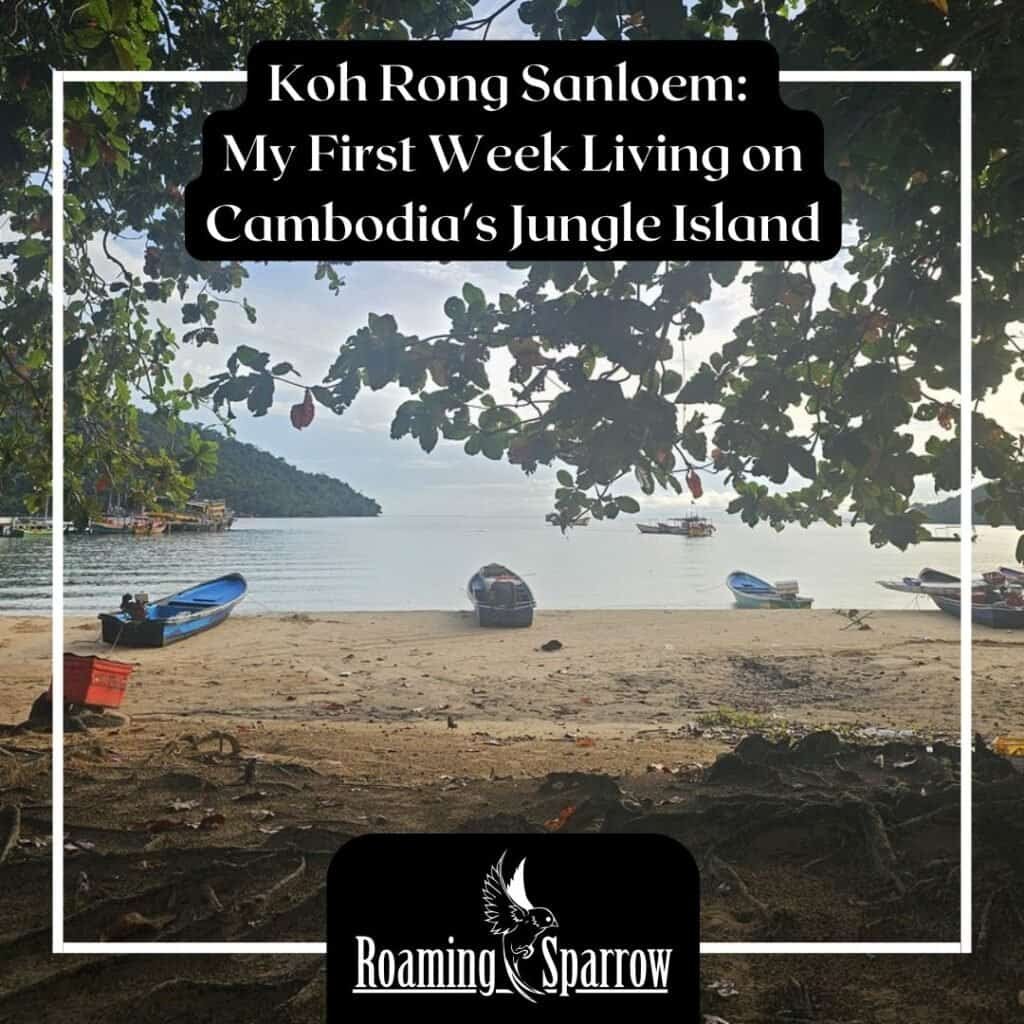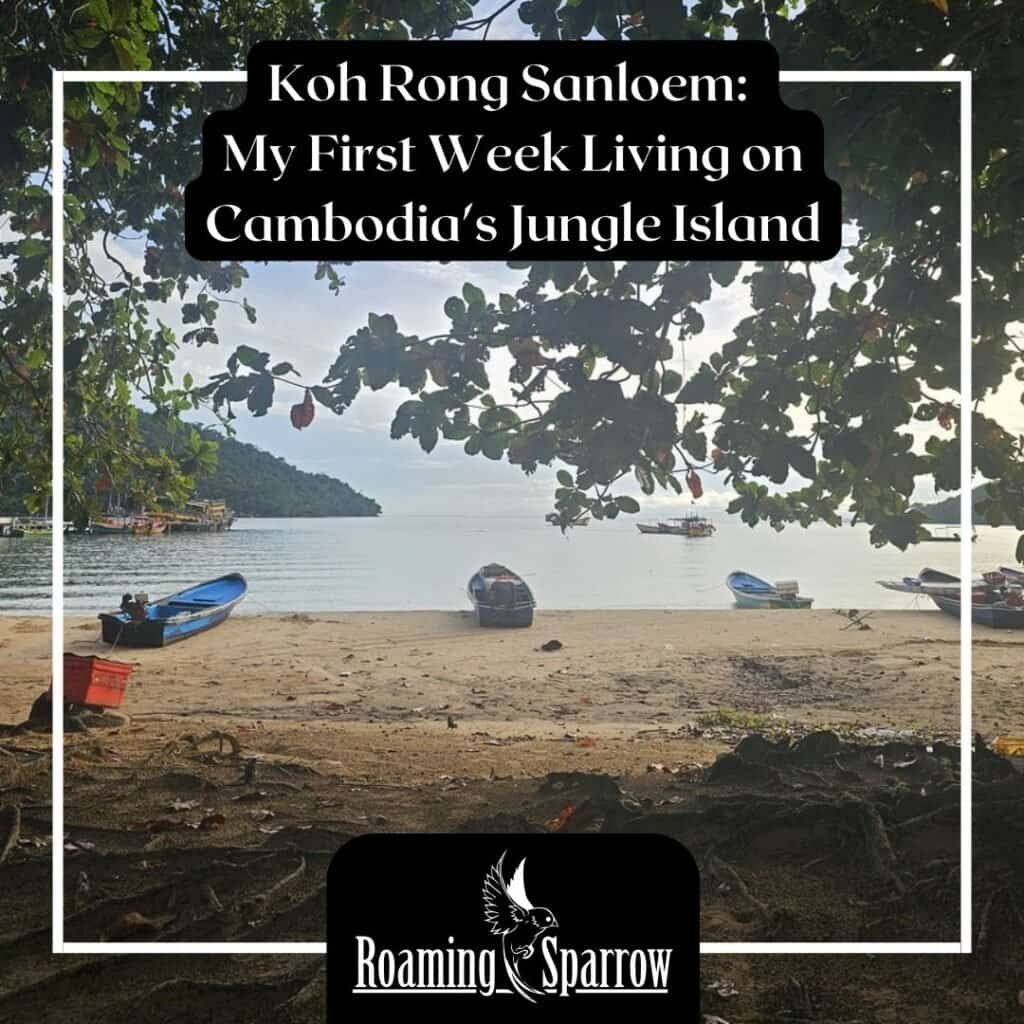

The ferry cut through the Gulf of Thailand, leaving Sihanoukville’s chaotic shoreline fading into the distance behind me. Thirty minutes and fourteen dollars—that’s all it takes to completely change your life. Three days ago, I made that trade, stepping off solid ground and onto a boat bound for Koh Rong Sanloem, a jungle-covered island off Cambodia’s southern coast where I’d be living for the next seven months.
I wasn’t entirely sure what I was getting myself into. But that’s the thing about real adventure—you rarely are.

The Ferry Ride That Changes Everything
The ride started smooth enough. The one-way ticket from Sihanoukville ran about fourteen bucks, and as the boat picked up speed, I found myself looking back at the mainland city shrinking against the horizon. There’s something about watching solid ground disappear that makes you commit to whatever comes next. No turning back now—literally.
About halfway through the journey, the sky opened up. Rain hammered down on the boat’s roof, and when we pulled into our first stop at a bay down the island, the water was falling so hard it looked like the ocean’s surface was made of felt. I’d seen this effect once before at Freedom Beach in Thailand—watching rain collide with seawater creates this surreal texture that brings back memories of simpler travel days.
We made several stops along Koh Rong Sanloem‘s coastline before finally pulling into M’Pai Bay, the island’s main port. Even with rain still coming down, I grabbed my pack and walked down the small beach, past what would soon become familiar sights—the town, the village, the local spots that were all brand new to me in that moment.
The path led me over a long bridge flanked by two Naga snake statues on either side, their serpentine forms a reminder of Cambodia’s deep Buddhist and Hindu roots. And then I was there—standing at my new home, a temporary spot where I’d crash for a couple days before moving to the hostel where I’d be working. This was it. Koh Rong Sanloem was now my reality for the next seven months.

Finding Rhythm in Island Time
The last three days have been about establishing a routine. I’ve been trying to wake up around 6 AM, get down to the ocean by 6:30, knock out some exercise, take a swim in water that’s somehow always the perfect temperature, and then get the day rolling. There’s something about starting your morning in the ocean that resets everything. The mainland stress, the digital noise, the constant connectivity—it all washes away with the tide.
But island life on Koh Rong Sanloem isn’t without its challenges. The biggest issue I’m dealing with? No WiFi. Coming from Connecticut, then Vietnam, then the connected chaos of Sihanoukville, suddenly being cut off from reliable internet is jarring. I’m relying on my phone’s data, which burns through quickly and costs more than I’d like to admit.
Today I learned there are portable routers you can plug SIM chips into—same effect as phone data but more practical for actually getting work done. I’m planning to grab one this Friday when I head back to the mainland for my second rabies shot. Yeah, rabies shots. That’s the kind of thing you deal with when you commit to seven months on a jungle island.

The Reality of Jungle Living
People hear “tropical island” and think paradise. And sure, Koh Rong Sanloem is beautiful—the kind of beautiful that travel magazines try to capture but never quite get right. But it’s also a jungle. A real, living, breathing jungle with all the creatures that come with that territory.
Poisonous snakes live here. Scorpions hide in the shadows. Monkeys roam through looking for food to steal. King cobras—actual giant cobras—patrol the forest. There are beetles the size of your palm and bugs you’ve never seen unless you’ve spent real time in Southeast Asia. This isn’t a resort island with manicured beaches and controlled environments. This is raw nature, and you respect it or you suffer the consequences.
The hostel where I’ll be working comes alive with backpackers looking for that authentic island experience. Once I move over there, I’ll be walking to it every day, probably encountering plenty of wildlife along the way. It’s a far cry from the structured tourism of other islands in the region, and honestly, that’s exactly what drew me here.

Cambodia’s Complicated History
Being in Cambodia means confronting history that isn’t distant or abstract—it’s recent, and its echoes still ripple through daily life. The Khmer Rouge regime ended in 1979, which means plenty of people living on Koh Rong Sanloem remember those years or grew up in their immediate aftermath. That kind of trauma doesn’t just disappear.
You can see it in how communities function here, in the way people interact, in the structures that exist and the ones that don’t. Cambodia is rebuilding, has been rebuilding for decades, but that process is slow and complicated. Living here for seven months means I’ll be witnessing that process up close, becoming part of a community that’s still healing while trying to build a tourism industry and create opportunities for the next generation.
It’s humbling, honestly. Coming from the United States with all its problems but also its stability, landing in a place where the past is still very much present changes your perspective on what challenges really look like.

The hostel work starts soon, and with it comes the chance to build real community. I’ve done this before—running Break Outwards in Vietnam taught me how to connect people from different backgrounds, create spaces where travelers feel welcome, and facilitate experiences that go beyond the typical backpacker party scene. But doing it on Koh Rong Sanloem will be different.
Island communities operate on different rules. Everyone knows everyone. Resources are limited. The weather dictates schedules. Ferry connections to the mainland can be disrupted by storms. You can’t just run to the store when you need something—you plan ahead or you go without. This forced simplicity creates bonds between people that don’t form as easily in cities where convenience is king.
I’m curious to see how my mindset shifts over these months. Will the lack of constant connectivity make me more present? Will the jungle environment teach me patience I didn’t know I needed? Will the community here change how I think about work, purpose, and what actually matters?

The Learning Curve of Island Operations
The last few days have been practical—cleaning, organizing, trying to understand how life actually works on Koh Rong Sanloem. Where do you buy food? How much does it cost? What are the safe paths versus the ones where you might encounter a cobra? Which locals are helpful versus which ones are running scams on new arrivals?
Every island has its own vibe, its own unwritten rules, its own rhythm. Some parts of Koh Rong Sanloem cater to tourists looking for Instagram moments. Other parts remain authentically Cambodian, where fishermen still work like they have for generations and tourism is a strange new reality they’re still figuring out how to navigate.
M’Pai Bay sits somewhere in between. There’s development happening—new guesthouses, new restaurants, new beach bars—but it hasn’t crossed the line into overdevelopment yet. The question is whether it will stay balanced or tip into the same mass tourism that’s consumed other Southeast Asian islands.

What the Next Seven Months Might Bring
Boy, was I wrong about island life being simple relaxation. Three days in and I’m already dealing with WiFi logistics, wildlife awareness, community integration, historical context, and practical survival skills. And this is just the beginning.
The rainy season is still lingering, which means afternoon storms that can turn violent quickly. The dry season will eventually arrive, bringing with it different challenges—intense heat, more tourists, higher prices, busier beaches. The island’s character will shift with the seasons, and I’ll be here to experience all of it.
I’m looking forward to documenting this journey. Not just the highlights that look good on social media, but the real daily experience of what it means to commit to seven months on Koh Rong Sanloem. The struggles with connectivity. The encounters with wildlife. The relationships built with other travelers and locals. The moments when you question why you left comfortable mainland life. And the moments when you remember exactly why you did.

Following the Adventure Forward
To everyone who’s been following along—your likes, your comments, your messages—they genuinely keep me motivated to document this experience. Traveling solo means you’re your own accountability system, and knowing people are interested in where this adventure leads gives me inspiration to keep writing, keep exploring, keep pushing into uncomfortable territory.
This Friday’s trip back to Sihanoukville for the rabies shot will be interesting. After just a few days on Koh Rong Sanloem, will the mainland already feel overwhelming? Will I be eager to get back to island simplicity? Or will I be craving the conveniences I’ve been missing?
The portable router mission is priority one. Without reliable internet, documenting this experience becomes exponentially harder. But there’s something poetic about the struggle, about having to work harder to stay connected, about being forced to be more intentional with online time because it’s limited.

The Bigger Picture: Why Islands Matter
Living on Koh Rong Sanloem for seven months isn’t just about personal adventure—it’s about understanding how remote communities function, how tourism impacts local culture, how travelers can contribute positively versus just consuming experiences and moving on. The hostel work will put me at the intersection of those dynamics.
I’ve run bar crawls in Vietnam, built digital nomad communities, managed circus operations across multiple countries. But this feels different. More raw. More real. Less about creating experiences for others and more about being fully present in my own experience while also facilitating connections for the travelers who pass through.
The jungle around me is alive with sounds I’m still learning to identify. The ocean rhythm sets the daily pace. The storms remind you who’s actually in control here. And the community—both local Cambodians and international travelers—creates this unique ecosystem that doesn’t exist anywhere else.

Looking Ahead from M’Pai Bay
Three days down, seven months to go. The adventure has barely started, but already Koh Rong Sanloem is teaching me lessons I didn’t know I needed to learn. About patience. About adaptation. About what happens when you remove convenience and force yourself to operate on island time.
The bridge with the Naga snakes that I crossed on arrival? I’ll walk that bridge hundreds of times over the next months. It’ll become familiar, mundane even. But right now it still feels symbolic—leaving one world behind, entering another, with guardian spirits watching the transition.
That’s what real travel is about. Not the one-week vacation where everything is planned and comfortable. But the commitment to stay somewhere long enough that it stops being exotic and starts being home. Long enough that you understand the rhythms, know the locals by name, recognize the regular travelers who cycle through.
So here’s to seven months on this jungle island off Cambodia’s coast. To morning swims and afternoon storms. To WiFi struggles and wildlife encounters. To building community and learning patience. To documenting the journey and seeing where it leads.
Thanks for following along. The adventure is just beginning, and I have a feeling Koh Rong Sanloem has plenty more lessons to teach.
Read my Cambodia Travel Guide here: https://roamingsparrow.com/destinations/cambodia-travel-guide/
